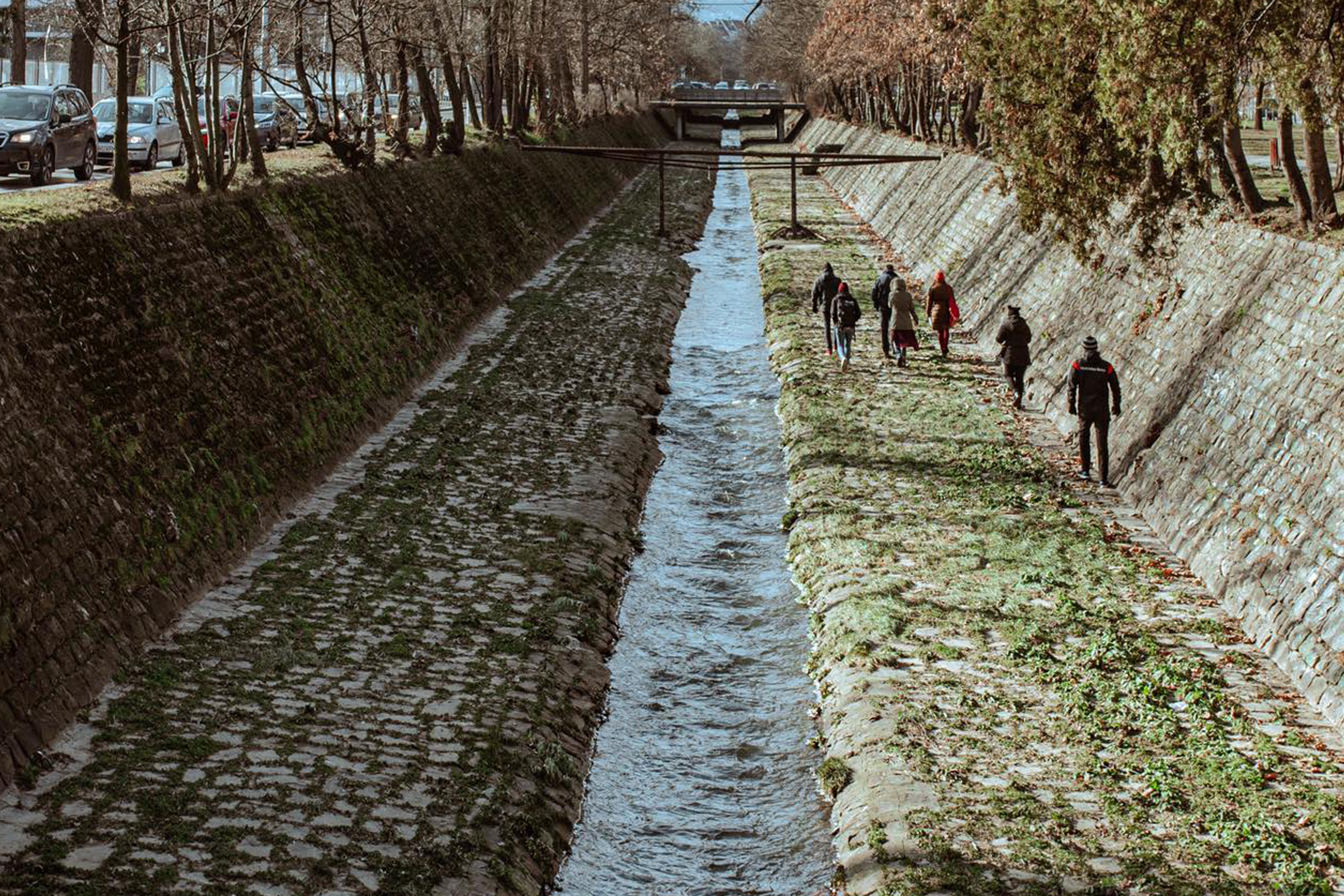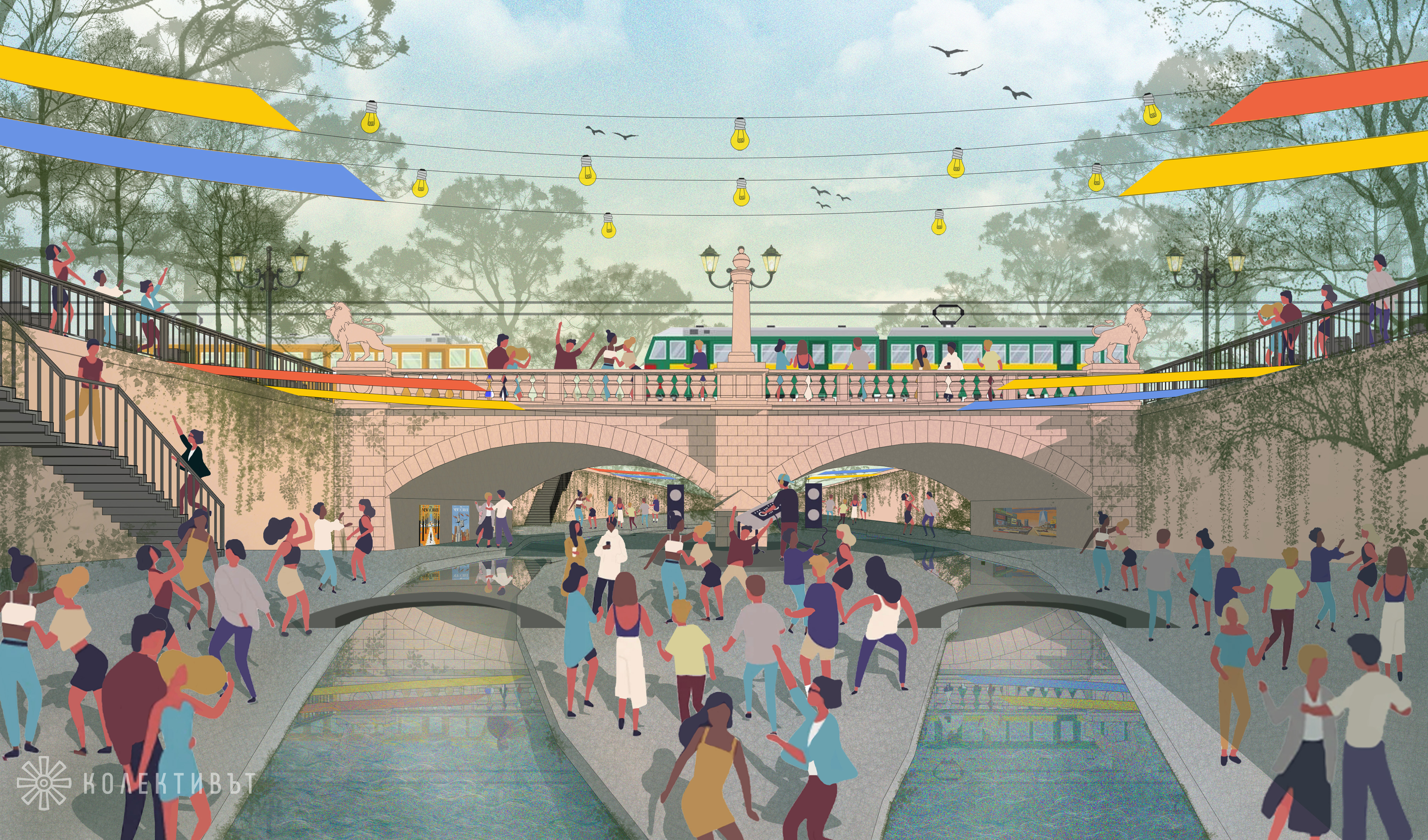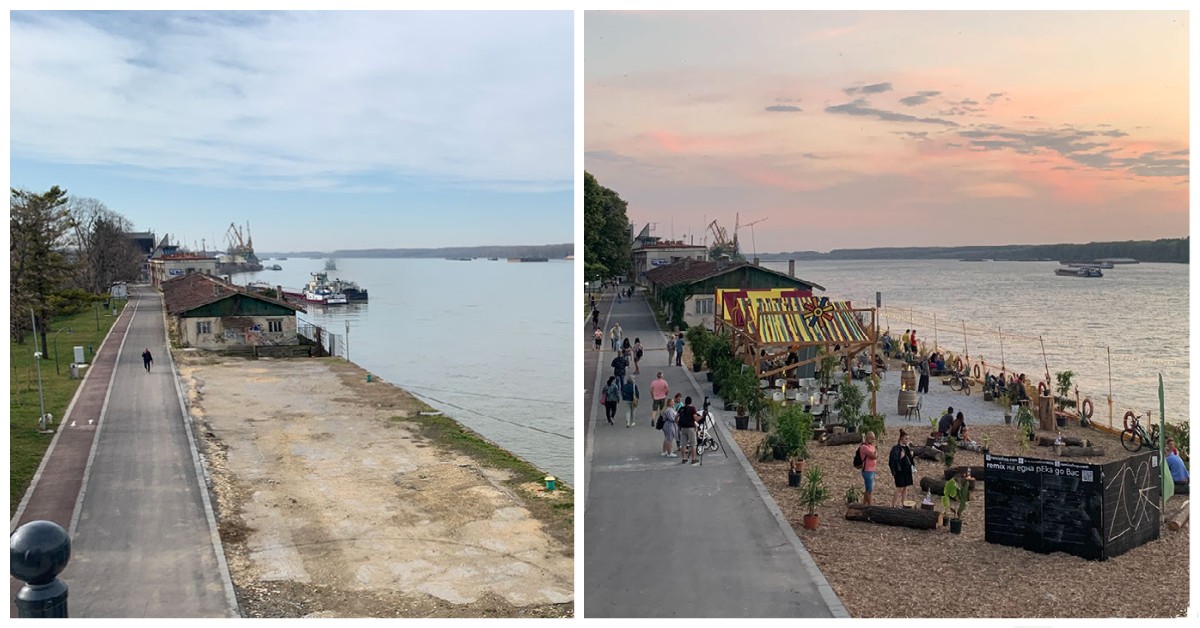The Rivers of Sofia project united citizens, experts, and the private sector in reviving rundown riverbanks that had been inaccessible since the 1940s. Architectural interventions, festivals, and a collaborative working group transformed the rivers into gathering space for diverse groups. It restored the rivers’ connection to the city and reclaimed a place for urban nature in Sofia. It also opened up civic and institutional dialogue about waterways’ future and catalysed long-term change.
Sofia is a city with over 30 rivers that form a key part of its cultural and natural heritage. The Rivers of Sofia project united various stakeholders - citizens, experts, the public and private sector - in reviving the rundown and polluted riverbanks. The project consisted of temporary architectural interventions, festivals, and a collaborative working group of students, experts, and municipal leaders. This range of activities transformed the riverbanks and people’s perception of them. The project turned the banks into gathering space for diverse groups, restored the rivers’ connection to the city, and reclaimed a place for urban nature in Sofia. It also opened up civic and institutional dialogue about the rivers’ future and catalysed long-term change.
At the two Rivers of Sofia festivals, in 2020 and 2021, light architectural interventions at key locations and a cultural, educational, and sports programme demonstrated the banks can turn into thriving public spaces. Over 100 media outlets reported on the project, and over 20,000 people visited the festivals. Architecture and collective celebration generated momentum for urban change.
A working group of university students and experts in architecture and urbanism worked together with Sofia’s Chief Architect to turn the temporary interventions into long-term solutions for integrating the rivers into the city and reconnecting residents with nature. The project proposed a model for collective urban development focused on inclusion and accessibility. Rivers, which have traditionally acted as boundaries and traffic arteries in the city, are activated as connecting elements that integrate neighborhoods and bring people together. This holistic project, which combined physical transformation, a shared site-specific experience, and dialogue with the responsible institutions, has led to a dramatic shift in the rivers’ future and a commitment by the municipality to restore them as rewilded public spaces.
Please highlight how the project can be exemplary in this context
This was a project with a light ecological footprint, as the physical interventions consisted of structures that were disassembled and reused in the two festivals. Temporary stages were made of wooden slats; standard industrial scaffolding was used for the stairs; the pavilions and tents were erected from poles and cloth. These light, movable structures present a simple and affordable solution for transforming spaces sustainably, without significant alterations in the natural or built environment. The festivals also succeeded in using cultural and commercial resources available within the city: local artists, performers, and small businesses helped make them happen. No travel was necessary. We gathered the talent and creativity available within our city, and simple interventions led to maximum aesthetic and social impact.
The project was sustainable in another sense, too. Not only was it light in terms of its direct ecological footprint; we also aimed for sustainable, long-term change, including social sustainability. The Rivers of Sofia started as a set of targeted urban interventions, cultural programming, and civic dialogue. By the end, it created lasting change by securing public commitment from Sofia Municipality that the rivers will be restored so the city’s natural resources will be reconnected with the urban fabric and its people. Sofia Municipality has set the rivers as a priority in its candidacy for the Green European Capital competition in 2022, with a budget of 40 million EUR, as well as in the “Sofia Chooses Green” competition for urban projects this year. Funds have been set aside to restore nature and accessibility along the rivers. The project is exemplary in its strategy of using targeted urban interventions or ‘urban acupuncture’ to achieve larger-scale urbanistic impact, as well as in its holistic approach that combines bottom-up community building, advocacy, architecture, and culture.
Please highlight how the project can be exemplary in this context
The light temporary structures were used to integrate the rivers into the city fabric. The river beds were connected to the street level and bridged to turn them into unified spaces with continuous foot traffic and gatherings on both sides. (https://youtu.be/kU8j5XXckzM)
Multicoloured ribbon and cloth stretched over the river to create a canopy that visually united the opposite banks. Decor and lighting were used to unify the design and to create at once a sense of wonder and of comfort in a previously inhospitable place. Colourful tents served as pavilions for different activities or quieter spaces for relaxation.
One of the locations, on the Perlovska River, offered a more active promenade with various shows on the many temporary bridges. Between the bridges and pavilions, ‘paper ship’ sculptures of wood and cloth, and lit up from inside, were suspended over the water, creating the illusion of floating. This turned the canal from a place citizens perceived as dirty and off-limits to a space of play and celebration. Urban furniture and greenery transformed the banks of roughly hewn stone into inviting, cozy spaces. Throughout, tents, pavilions, and stages created promenades for circulation and observation, as well as repose. A simple water filtration station was installed upstream to remove garbage, and greenery and shading allowed people to spend time by the rivers for the first time.Overall, affordable prefab materials were utilized to achieve a unified design that connected the riverbeds with the street level and the opposite banks with each other. The rivers were restored as part of the city both physically and in the popular imagination. We opened up new public space, created a delightful experience with art and music, and allowed for active circulation as well as contemplation.
Please highlight how the project can be exemplary in this context
The project was conceived with inclusion in mind: the goal was to open up public space by the rivers that would be welcoming to diverse social groups. The design defined areas for active participation and relaxation so people would be able to engage in different ways depending on age, interests, neurodiversity, etc. Further, the range of activities actively targeted diverse groups. They included sports and activities for children. At one of the locations, an outdoor bazaar formed an extension of Zhenski Pazar, a market at the heart of Sofia’s most diverse neighbourhood. This connected the festival to its context and drew in local people. Typically, there is no programming that brings Roma, Arab and Bulgarian people together, but the Rivers of Sofia opened up such a space. The events were free and open to all.
Beyond the design and programming, the project prioritised inclusion at all stages. Over 30 partner organisations from different sectors took part. The project engaged artists and performers from diverse backgrounds, who shaped the experience. Collaborative design was the principle of the working group where students worked side-by-side with established professionals: together, they proposed ideas for the rivers’ development as part of the city, which Sofia Municipality later made part of its funding priorities. Residents of adjacent neighbourhoods took part in constructing the architectural interventions in a process of collective placemaking. This helped create a broadly shared sense of public space, which, together with the multi-channel communications campaign, changed public perception of the rivers. The tens of thousands of people who visited developed a new relationship with urban nature in Sofia and the value it provides beyond mere utility -- in terms of aesthetic experience, recreation, and openness for all. The project is exemplary in the way inclusion is embedded as a principle at all stages.
Please highlight how this approach can be exemplary
The project combines inclusion, sustainability and aesthetics in a unified approach that achieves lasting urban, as well as social change. It employs aesthetic transformation and cultural programming as a means to change public perception of sites where the connection to nature is broken and to involve diverse communities of stakeholders in broadening the impact. The Rivers of Sofia’s main goal is greener urbanism with clean, rewilded rivers turned into public space and green mobility corridors. This goal is promoted in an innovative way, by engaging the public in aesthetic experiences and communal activities. Inclusion and aesthetic transformation thus become innovative vehicles for green urbanism. A proposal for greening Sofia’s rivers would not have been as effective without the broad public engagement that gained momentum and incited the authorities to get involved, and without the memorable experiences and architectural designs.
The project demonstrated clearly that green urbanism is collective urbanism that unites diverse stakeholders, from residents to officials, and that beautiful design is essential to gain more attention and support.
The Rivers of Sofia project achieved its long-term goal of using targeted architectural interventions, programming, and dialogue to improve the condition of Sofia’s urban rivers and to reconnect them with the city, making them accessible to the public.
The project aimed to address the broader issue of rivers’ disconnect from urban life since they started being used for industrial purposes two centuries ago. In the late 1930s and 1940s, Perlovska and Vladayska Rivers were channelled into artificial riverbeds of hewn stone that cut off the connection between the street level and the water and stopped public access. The rivers’ biodiversity was impacted, as vegetation as well as fish and other animals lost their habitat. Problems intensified in the later 20th century, as Sofia continued to grow and the urban sewage infrastructure began to frequently overflow into the rivers, completely destroying ecosystems.
The Rivers of Sofia used light architectural interventions that aesthetically transformed the rivers to demonstrate how the banks could turn into common, shared spaces for different social groups. The physical transformations employed transdisciplinary approaches and participatory processes. Over 20,000 people visited on-site, while the communications campaign reached over 100,000 people on social media. This helped to secure commitment from the responsible institutions to permanently restore these spaces in line with the public’s interest. Sofia Municipality has committed 40 million EUR to 7 green projects in 2022, one of which is the urban riverbeds.
The Rivers of Sofia initiated a new urbanism that uses nature as its organising principle and treats the rivers as valuable public resources rather than boundaries or waste disposal sites. The Rivers of Sofia caused Sofia Municipality to make the rivers a priority and to divert millions in funding towards orienting urban development around them as a natural and civic resource.
Please also explain the benefits that derived from their involvement.
The project involved a wide network of over 30 partners, including cultural and civic organisations and local businesses, who helped shape the events programme, donated construction materials and greenery, boosted the communications campaign, and provided funds. Sustainability-oriented organisations such as Greenpeace and Rewilding Europe took part in educational activities to help residents imagine a different possible future for the rivers and to promote reconnecting with nature. University students were involved together with experts and local officials in a collaborative design working group that made proposals for the rivers’ restoration and use, which were later adopted by Sofia Municipality. Local residents from the neighbourhoods around Vladayska River, which are the most diverse in Sofia, volunteered in constructing the architectural interventions on-site, thus creating a sense of community ownership. The programme was created by local artists, especially emerging artists from diverse backgrounds, who were able to reach new audiences in this alternative location.
The broad public engagement of different groups made a strong case to local authorities for the cause of the rivers and reconnecting with urban nature. This wide involvement ultimately made the project successful in imagining and enacting a different possible future for urban rivers. The collaborative design process made the spaces, both during the temporary interventions and the long-term transformation that is now planned as a result of the project, more diverse in terms of functionality and the groups they include. The involvement of diverse artists and creators, including modern circus and graffiti artists, puppet theatre performers, dancers, childrens’ arts facilitators and many others in the programme also helped attract different audiences and make the riverbanks inclusive and welcoming areas close to nature.
Modern urban planning has been characterised by a disconnect from nature and the principle of controlling it, rather than integrating it throughout the urban fabric. On a global level, cities have become more disconnected from waterways that were essential in their development, including as resources for shipping and industry. In the modern era, rivers have been treated as waste disposal systems and as resources for industrial production. While industrialisation and urbanisation have severely impacted biodiversity in rivers and have caused people to remain disconnected from them, urban waterways have a great potential to restore nature even in dense cities and to open up wilder landscapes and green mobility arteries across neighborhoods. The global challenge is designing cities in line with nature, not against it -- adopting a nature-centred perspective and letting rivers and their natural ecosystems lead the way. The Rivers of Sofia showed a context-specific, affordable and accessible way to galvanise communities around this idea and advocate for nature in a dense city. While the project was adapted to local communities and traditions and respected the architectural heritage of the stone riverbeds, it also presented a model for bringing people closer to nature that can be applied anywhere. Light, targeted interventions can build community and effectively change people’s relationship to neglected urban nature that is often closer than we think.
The project was innovative in that it operated at different scales at once, using both hyperlocal, targeted interventions that fit in the context of specific neighborhoods, and a broader campaign for urban rivers that became active on the national level. Interventions at three locations on the rivers attracted over 20,000 people in 2020 and 2021 and turned some of the most rundown spaces in Sofia into active public spaces. At the same time, the project also sparked policy change. It combined grassroots activism with advocacy at the institutional level, and it involved design on the hyperlocal as well as the city level. This makes it a state-of-the-art project in the fields of urban architectural interventions, collective placemaking, and green urbanism. The Rivers of Sofia is different from limited artistic interventions, research projects, and urbanism projects in that it combines elements of all three into an effective holistic approach. It involves people on the street, policymakers, business leaders, artists, and everyone in between to reshape specific sites, as well as the city as a whole and popular perceptions of urban waterways in general.
Please provide clear documentation, communication of methodology and principles in this context.
The project’s results are highly replicable and The Rivers of Sofia has already generated a subsequent initiative, The Rivers of the City, that is active in several cities in Bulgaria. We have distilled a method of connecting cities with their rivers by means of co-design, advocacy, and shared experiences aligned with local traditions and heritage.
Collaborative design workshops with youth and local policymakers, including feedback from other local stakeholders, lead to architectural interventions designed according to local needs. Our organisation then unites partners in the public and private sector to help realise the designs and advocates for rivers as public spaces close to nature to the relevant authorities. The architectural interventions are realised together with volunteers from the community and a cultural programme uniting local talent activates the new spaces.
Once momentum starts going, this is followed by a larger urbanist vision for connecting the urban fabric to the river and creating permanent public space close to nature. This vision is again presented to authorities with wide support from the public. Our initiative was successfully transferred to Ruse, where a placemaking intervention on the Danube River and a festival will take place for the second time in 2022. A follow-up project is already underway to propose a nature-centred urban development strategy for the city. Analogous initiatives as part of The Rivers of the City are starting up in Vidin and Veliko Tarnovo as well. The Rivers of the City applies the same principle of community involvement, uniting different sectors - civic society, business, local government. It also employs aesthetic transformation as a way to reconnect people with nature. The methodology has successfully been transferred and scaled up, and it can be applied anywhere in Europe and beyond.





@The Collective Foundation, 2021
Content licensed to the European Union.